NAM Collection 2024 III Another Landscapes
October 10th – December 17th, 2024, Nagano Prefectural Art Museum, Main Building 2F, Collection Gallery (Nagano)
Guest Curator: Yuki Harada
NAMコレクション2024 第Ⅲ期 もうひとつの風景
2024年10月10日 – 12月17日、長野県立美術館 本館2階コレクション展示室 (長野)
ゲストキュレーター:原田裕規

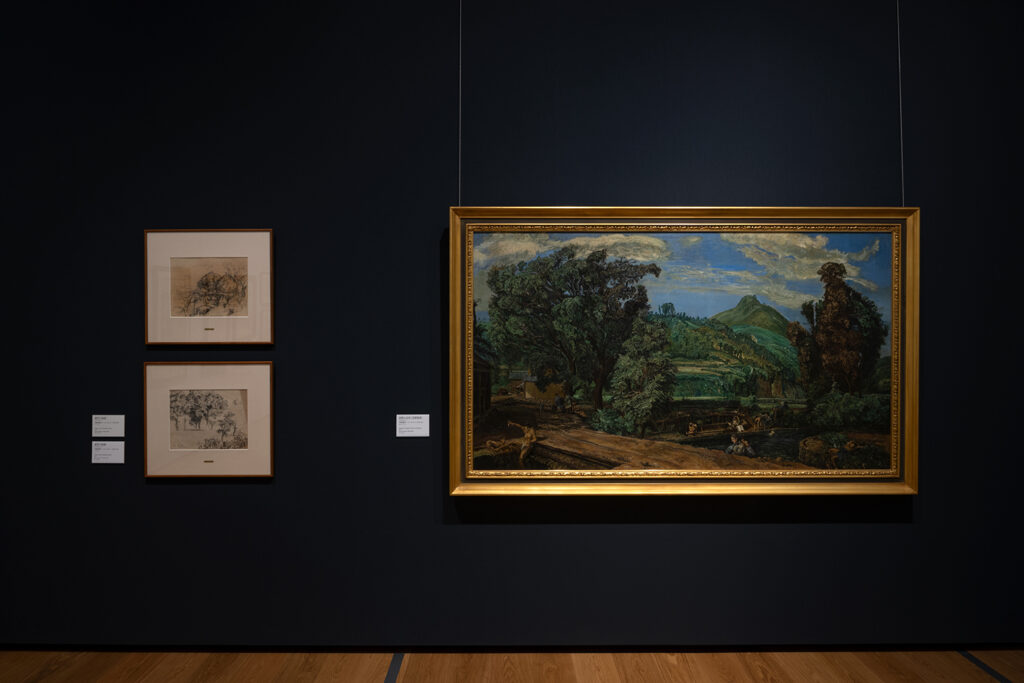
》1915年-1024x586.jpg)
河野通勢《長野の近郊(長野風景)》1915年
Drawing from the Nagano Prefectural Art Museum’s collection—formed primarily around artists from the Shinshū region and works depicting its landscapes—this year-round exhibition series features a wide range of works, including Western-style painting, Nihonga (Japanese-style painting), and crafts.
The third phase of the 2024 NAM Collection includes a special feature titled Another Landscape (Guest Curator: Yuki Harada), presented in conjunction with Open Studio vol.4 Yuki Harada: Dreamscape.
Shinshū, a region surrounded by some of Japan’s most celebrated mountains and known for its rich natural beauty, has long served as a subject for landscape painters. It is also the birthplace of major figures in the Japanese art world, such as Shunsō Hishida and Kogetsu Saigō, whose works frequently evoke the natural scenery of the region. Yet Shinshū is also home to lesser-known narratives—“another landscape,” so to speak. One example is Seppō Akahane (born in Matsumoto), a contemporary of Hishida and Saigō who chose to study alone in the United States and has since faded from the mainstream art historical canon.
Another key figure is Yutaka Matsuzawa (born in Suwa), recognized as one of Japan’s leading conceptual artists. His works based on real sites such as the Yashima Marsh (wilderness) and Lake Suwa (lake) are often approached as “conceptual” or “idea-based” and thus perceived as difficult. However, by reconnecting these pieces to the actual landscapes that inspired them, one may begin to see a different dimension to Matsuzawa’s practice: a form of landscape painting in its own right—another landscape.
The exhibition also includes landscapes of Shinshū by Michisei Kōno, Kazuo Tamura, Hiroshi Yoshida, Shinsui Itō, and others, alongside Yuki Harada’s performance work Painting to Be Shown to the Lake (Monk by the Sea) (2022), which was inspired by Matsuzawa’s Fundamental Painting Exhibition to Be Shown to the Lake (1967). Through diverse formats ranging from painting to performance, Another Landscape introduces overlooked or alternative perspectives on the landscapes of Shinshū.
信州出身の作家たちや、信州の風景が描かれた作品を中心に形成された長野県立美術館のコレクションから、一年を通して、洋画、日本画、工芸等さまざまなジャンルの収蔵品を展示します。
2024年の第Ⅲ期では、「公開制作vol.4 原田裕規 ドリームスケープ」の連動企画として「もうひとつの風景」(ゲストキュレーター:原田裕規)を開催します。
日本有数の名山に囲まれ、自然豊かな地として多くの風景画の舞台となった信州からは、菱田春草や西郷孤月ら、中央画壇を代表する画家が輩出されました。彼らの描く風景には、信州の自然を感じさせる表現が多数散見されます。しかしそれのみならず、菱田や西郷らの同級生でありながら、単身アメリカに渡ったことで「知られざる存在」となりつつある赤羽雪邦(松本出身)など、信州には主流だけでなく傍流の系譜、いわば「もうひとつの風景」も存在します。
さらに、日本を代表するコンセプチュアル・アーティストとして知られる松澤宥(諏訪出身)は、八島湿原を念頭に置いた「荒野」の作品や、諏訪湖を題材にした「湖」の作品などを発表してきました。これらの「言葉による作品」は、従来難解な「観念美術」として捉えられがちですが、題材となった現実の風景から捉え直すことで、松澤作品の風景画としての側面(=もうひとつの風景)が浮かび上がります。
そのほかにも、河野通勢、田村一男、吉田博、伊東深水などによる信州を描いた風景画や、松澤の《湖に見せる根本絵画展》(1967)に着想を得た原田のパフォーマンス作品《湖に見せる絵(海辺の僧侶)》(2022)など、絵画からパフォーマンスまで幅広い形態の作品を通して、信州の「もうひとつの風景」を紹介します。
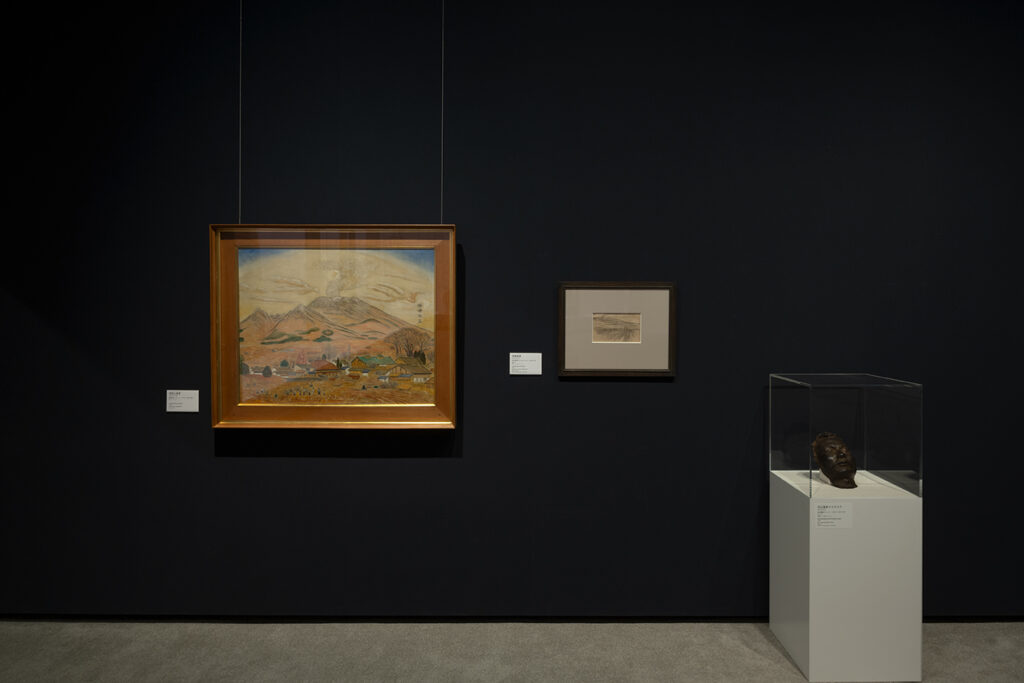

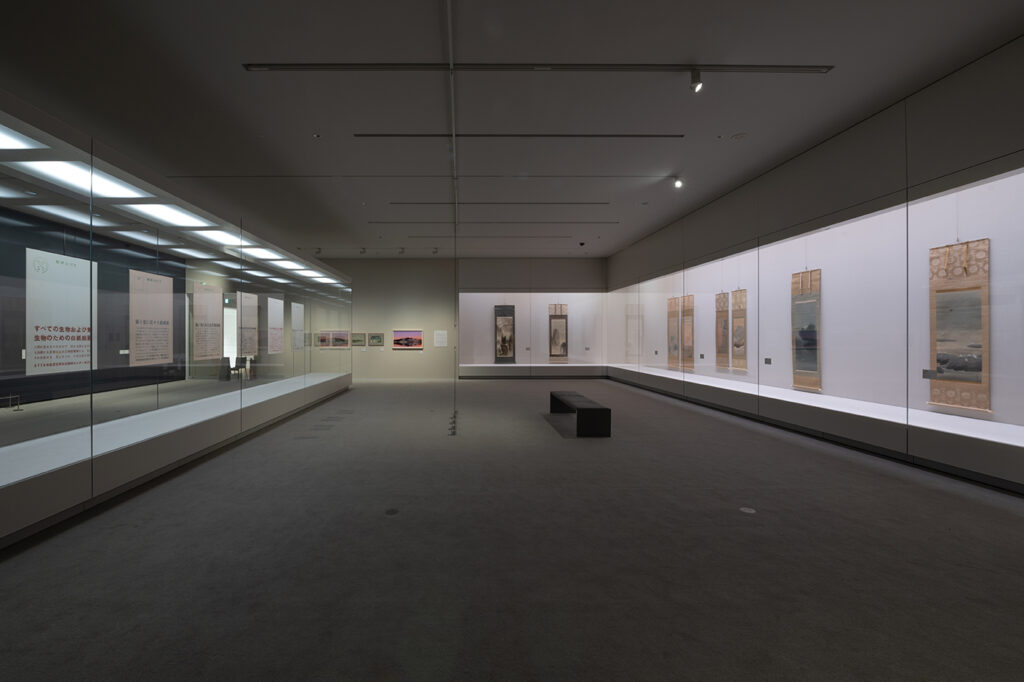
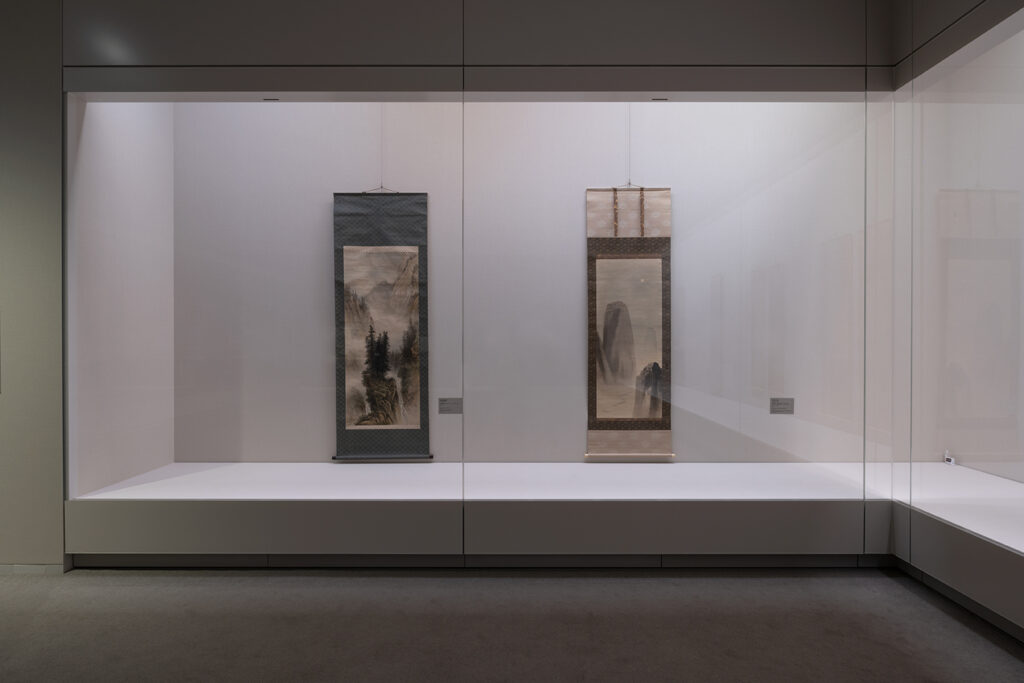
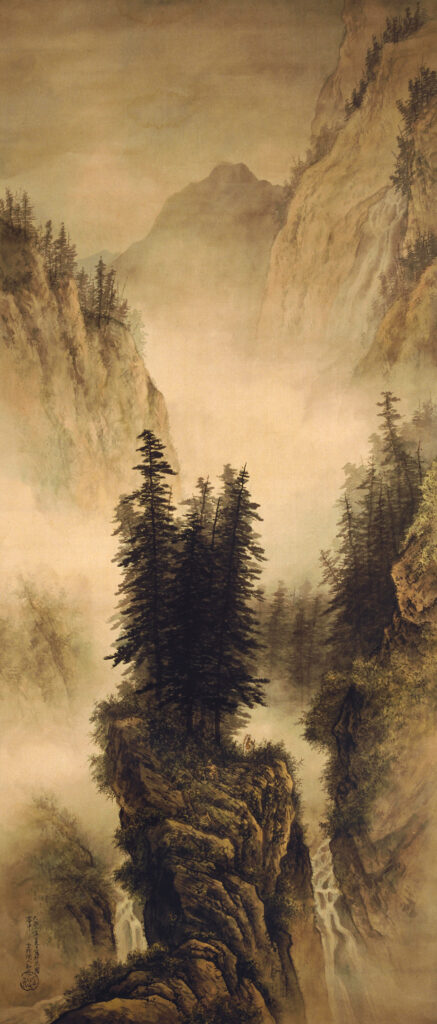
赤羽雪邦《米国風景》1914年
Journeying Through Another Landscape
“It feels like a dream.”
That thought once crossed my mind as I stood before Mishaka Pond in Chino City, a site immortalized in Green Resonant (1982) by Kaii Higashiyama. And Mishaka Pond isn’t the only one—Lake Nozomi, Lake Suwa, the Yashima Marsh, Kamikōchi… While walking through the Shinshu region, one often stumbles upon landscapes so surreal they seem lifted from a dream.
At first glance, Green Resonant appears to be the result of a painter’s unique and original vision. “How did Higashiyama imagine something like this?” I wondered—until I actually visited the site myself. Only then did I realize: it wasn’t that the artist invented the scene, but rather that the real landscape preceded the artwork, and the painter’s imagination followed its contours—almost like shadowing it.
Viewing the collection of the Nagano Prefectural Art Museum from this perspective reveals that many of its works were born as “shadows of landscapes.” Take, for example, Michisei Kōno, whose works are known for their distinct and peculiar style, often depicting the banks of the Susobana River in Nagano City. When I walked along the very same riverbanks he once painted, I was struck to see cliffs shaped like reptiles and twisted willow trees—forms that echoed Kōno’s idiosyncratic style almost exactly.
The same could be said of another figure: Yutaka Matsuzawa, internationally recognized for his conceptual art. His works, largely constructed from “language,” are often considered difficult or opaque. But a closer look reveals that many of them are deeply rooted in the land around Suwa, where Matsuzawa lived. His practice might be described as conceptual art as landscape expression.
The idea that Shinshu’s landscapes have long inspired artists has led me to consider a new framework—one that links two seemingly opposed domains: landscape representation and conceptual art.
Finally, I’d like to introduce a work that brings a contemporary resonance to this journey through Shinshu’s artistic landscapes. Seppo Akahane, a painter born in the final years of the Edo period, studied alongside major figures such as Taikan Yokoyama, Kanzan Shimomura, and Kogetsu Saigō as part of the first graduating class of the Tokyo Fine Arts School. In his early career, Akahane stood on the cusp of success within the central art world. Yet after graduation, he left for the United States alone and became a “forgotten painter” back in Japan. His American Landscape (1914), painted after his emigration, is a strange and haunting work: a traditional sansuiga (East Asian-style landscape painting) that includes the figure of a Native American.
When I first saw this piece—which felt like a hybrid of sansuiga and the Hudson River School (a 19th-century American landscape movement)—I was deeply moved. I’ve long believed that Hudson River School paintings influenced the visual aesthetic of tech giants like Microsoft and Apple, and that their influence persists today in the form of desktop wallpapers—contemporary “landscape paintings” that have come to be known as dreamscapes. In fact, I’ve come to see these dreamscapes as closely aligned with the work of Matsuzawa and other conceptual artists, who sought to express “invisible landscapes” through language.
Hudson River School. Conceptualism. Dreamscape—These three seemingly separate strands suddenly came together for me—through the landscapes of Shinshu. Of course, this is not an academically substantiated theory. It may well be dismissed as the idle speculation of an artist.
But just as I mentioned earlier—how Higashiyama and Matsuzawa created their work by allowing themselves to be pulled toward real-world landscapes—I too, as a contemporary artist, want to be pulled toward existing works as I plan this exhibition. Perhaps, somewhere along this journey, we might catch a glimpse of “another landscape,” one that earlier artists arrived at without even intending to.
—Yuki Harada (Artist / Guest Curator)


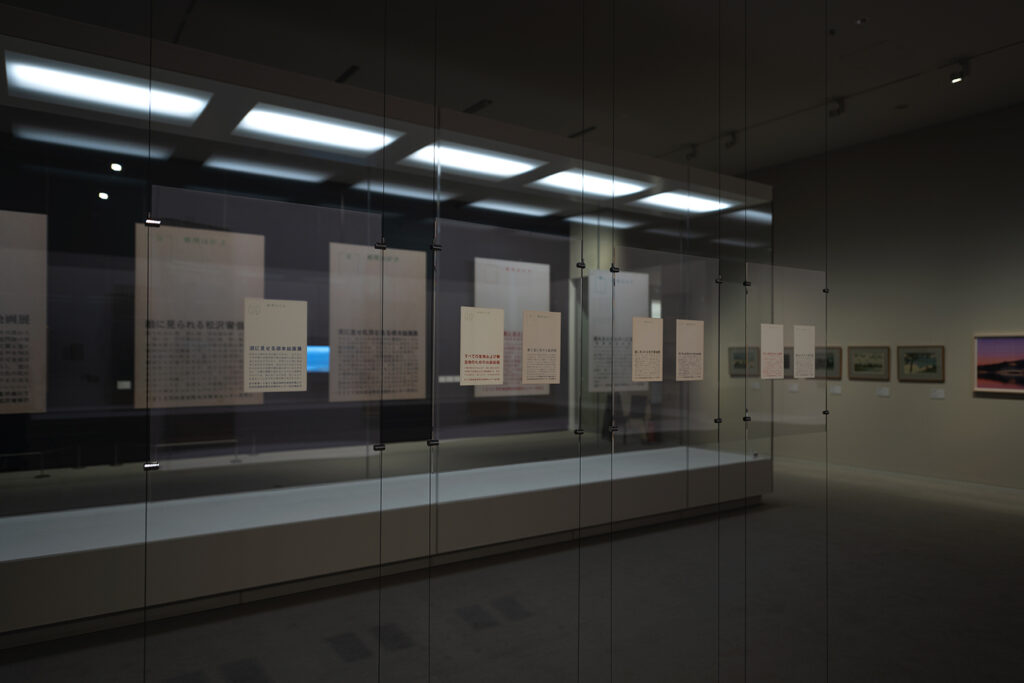
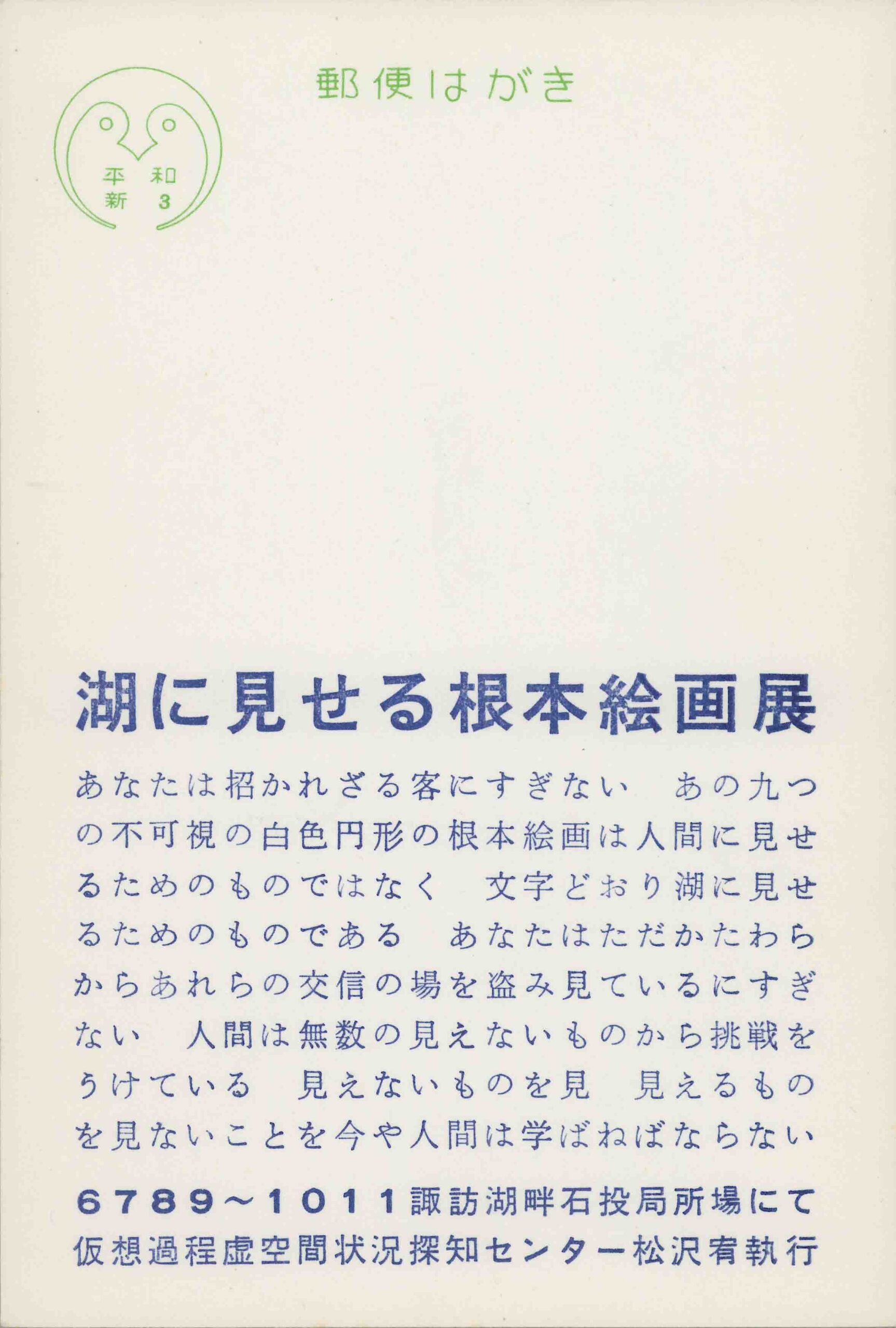
Yutaka Matsuzawa, Fundamental Painting Exhibition to Be Shown to the Lake, 1967
松澤宥《湖に見せる根本絵画展》1967年
もうひとつの風景を旅する
まるで夢のような風景だ──東山魁夷が描いた御射鹿池(茅野市)を目前にしたとき、思わずそう思ったことがある。それだけでない。希望湖、諏訪湖、八島湿原、上高地。信州を歩いていると、浮世離れした「夢のような風景」と出くわすことは珍しくない。
御射鹿池を描いた東山の《緑響く》(1982)は、一見すると独創的なアイデアによって描かれた作品に見える。「なぜ、東山はこんなビジョンを思いついたのだろう?」──御射鹿池を訪れる前までは、ぼくもそんな風に思っていた。しかし実際に現地を訪れてみてわかったことは、東山の作品よりも先に現実の風景があり、画家の想像力はそれに引っ張られるかたちで(いわば影を追いかけるようにして)生み出されたということだ。
そのような視点で長野県立美術館の作品を見つめ直すと、じつに多くの作品が「風景の影」として生み出されてきたことがわかる。「異形の風景」とでもいうべき特異な作風で知られる河野通勢は、長野市内の裾花川沿いを多く描いてきた。これも実際に彼が描いた川沿いを歩いてみると、まるで爬虫類のような形をした崖、曲がりくねった柳の木など、河野の画風そのままの風景が目前に現れて驚いたことがある。
それだけではない。コンセプチュアリズムの作家として世界的に知られる松澤宥は、その作品の多くが「言葉」によるものであるため、難解なものと思われることが多い。しかしよく見てみると、それらの多くが松澤の暮らした諏訪周辺の土地に触発されたものであることがわかる。それは「風景表現としてのコンセプチュアル・アート」とでもいうことができるのだ。
信州の風景がアーティストに想像力を与えてきたということ──こうした発想は、従来かけ離れたものとされがちな「風景表現とコンセプチュアル・アート」という二者を結びつけるアイデアをもたらしてくれた。
そして最後に、信州と風景表現をめぐる一連の旅に現代的なリアリティをもたらす作品を紹介したい。幕末生まれの画家、赤羽雪邦は、東京美術学校の1期生として、横山大観、下村観山、西郷孤月らと机を並べた仲だった。したがって、キャリア初期においては「中央画壇での成功」に最も近い位置にいた人物だったが、卒業後に単身アメリカに渡ったことで、日本からは「忘れられた画家」となってしまう。そんな赤羽が描いた《米国風景》(1914)は、伝統的な山水画の中にネイティブ・アメリカンの姿が描かれた奇妙な作品だ。
まるでハドソン・リバー派(アメリカの風景画の潮流)と山水画が融合したかのようなこの作品を初めて見たとき、強い衝撃を覚えることになった。なぜなら、ぼくはかねてより19世紀に隆盛したハドソン・リバー派の絵画はMicrosoftやAppleなどのアートワークに影響を与えたと考えており、現代人が普段目にする「風景画」であるパソコンのデスクトップアート(その一部は近年「ドリームスケープ」と呼ばれている)に姿を変えて、現代にも息づいていると考えていたからだ。さらに、こうした「ドリームスケープ」と美術史上で最も近い位置にいるのが、言葉によって「目に見えない風景」を表現しようとしてきたコンセプチュアリズムの表現、たとえば松澤の作品であると考えてもいた。
ハドソン・リバー派、コンセプチュアリズム、ドリームスケープ──信州の風景を経由することで、これまでバラバラに存在していた三者が突如として結びつくような感覚を覚えた。もちろん、これはアカデミックな調査に裏づけられた考えではない。アーティストのたわ言と思われても仕方ないのかもしれない。
しかし、先ほど東山や松澤らが「現実の風景に引っ張られるように」作品をつくってきたと述べたように、現代を生きるアーティストであるぼくも「現実の作品に引っ張られるように」展覧会を企画してみたいと思ったのだ。もしかするとその先には、かつてのアーティストが図らずもたどり着いた「もうひとつの風景」が広がっているのかもしれないのだから。
──原田裕規(アーティスト/本展ゲストキュレーター)
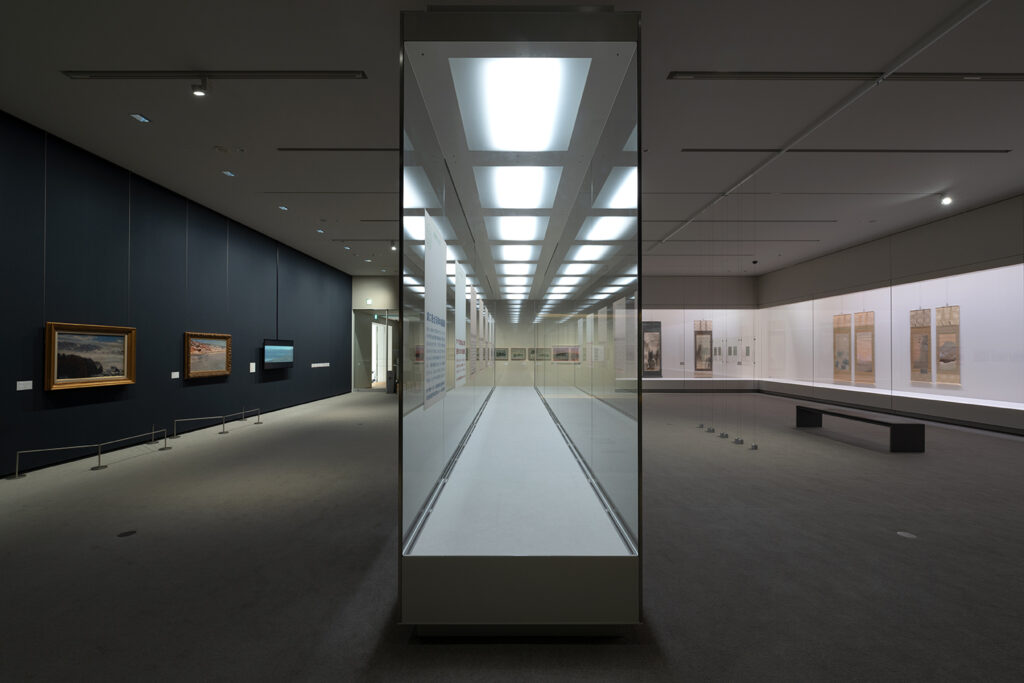
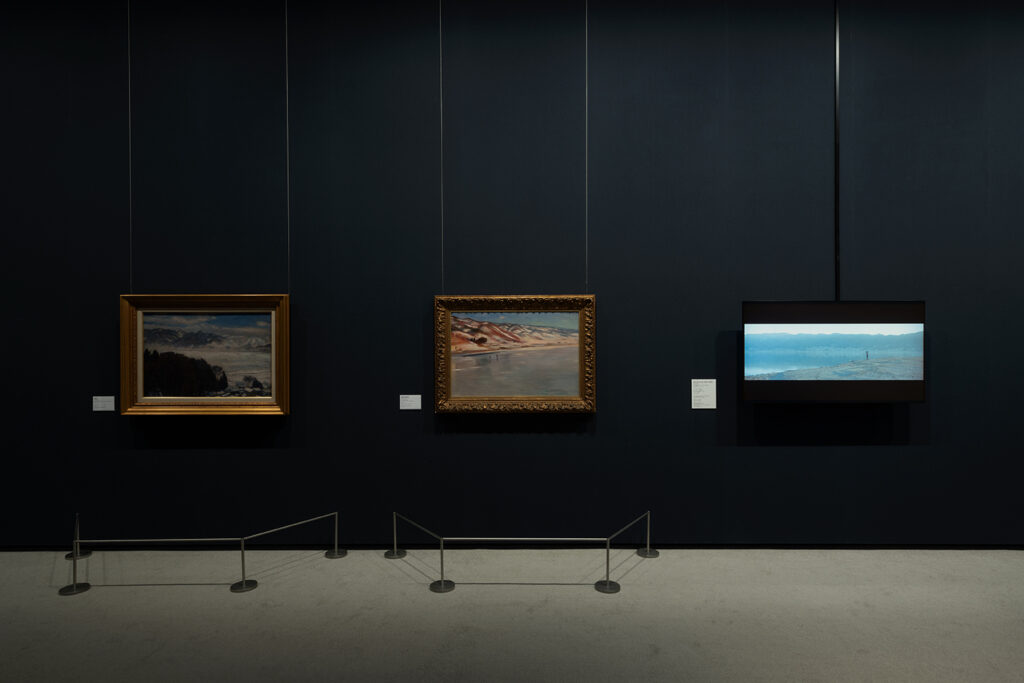
》2022年(特別出品)-1024x323.jpg)
原田裕規《湖に見せる絵(海辺の僧侶)》2022年(特別出品)

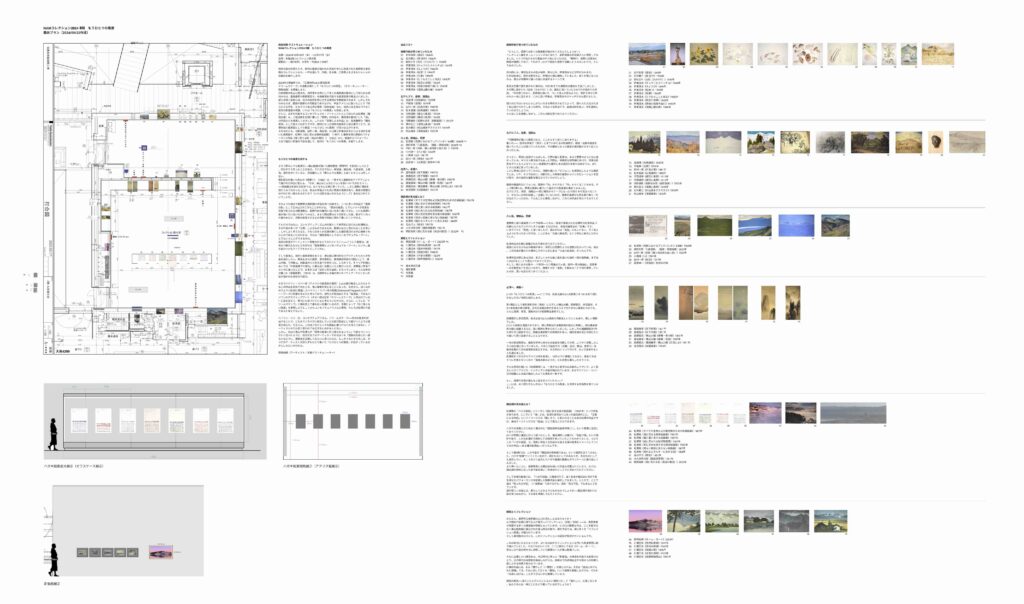
Exhibition Plan by Yuki Harada
Related Event
NAM Collection 2024 III Gallery Talk
Guest curator Yuki Harada will introduce the highlights of the NAM Collection 2024 III exhibition.
Date & Time: Saturday, October 19th, 2024, 14:00–15:00
Venue: Nagano Prefectural Art Museum, Main Building 2F, Collection Gallery
Capacity: Approximately 20 participants (first come, first served)
Registration: Not required (please come to the entrance of the Collection Gallery on the 2nd floor of the main building by 14:00)
Admission: Free (a valid exhibition ticket is required)
Click here for more details
関連イベント
NAMコレション2024 第Ⅲ期 ギャラリートーク
NAMコレクション展2024 第Ⅲ期の見どころをゲストキュレーターの原田裕規がご紹介いたします。
日時:2024年10月19日(土) 14:00–15:00
会場:長野県立美術館 本館2F コレクション展示室
定員:20名程度(先着順)
申込:不要(ご参加の方は、14:00までに本館2Fコレクション展示室入口にお越しください。)
参加費:無料(観覧券が必要となります)
詳細はこちら
—
NAM Collection 2024 III Another Landscapes
Period: October 10, 2024 (Thu) – December 17, 2024 (Tue)
Venue: Nagano Prefectural Art Museum, Collection Gallery
Organized by Nagano Prefecture, Nagano Prefectural Art Museum
Guest Curator: Yuki Harada
Museum Staff: Takeshi Kitaizumi, Naoko Shigehara, Yukino Suzuki, Mitsuha Furuie, Chieko Matsuura, Juri Yamashita
Install: Nippon Express Nagano Branch, Alp
Design: Kenta Shibano
Video Archive: Shintaro Watanabe, Megumi Fujita, Daisuke Tamochi
Photo Archive: Katsura Muramatsu (Calo works Co. Ltd.)
Cooperation: Hidetoshi Aoki
Website
Press Release (PDF/JP)
List of Works (PDF)
Artist Statement (PDF/JP)
Open Studio vol.4 Yuki Harada: Dreamscape
NAMコレクション2024 第Ⅲ期 もうひとつの風景
会期:2024年10月10日(木)– 12月17日(火)
会場:長野県立美術館 本館2階コレクション展示室
ゲストキュレーター:原田裕規
美術館スタッフ:北泉剛史、茂原奈保子、鈴木幸野、古家満葉、松浦千栄子、山下樹里
展示:日本通運長野支店、アルプ
デザイン:芝野健太
記録映像:渡辺真太郎、藤田恵実、多持大輔
記録写真:村松桂(株式会社カロワークス)
協力:青木英侃
展覧会ウェブサイト
プレスリリース(PDF)
出品作品リスト(PDF)
作家ステートメント
公開制作vol.4 原田裕規 ドリームスケープ